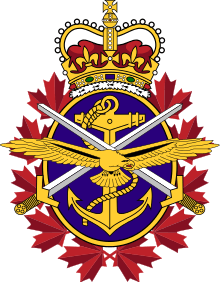Royal Canadian Ordnance Corps
| Royal Canadian Ordnance Corps | |
|---|---|
| Active | Disbanded/Decommissioned/Inactive |
| Country | Canada |
| Type | Corps |
| Role | (Canadian Army) Permanent Active Militia |
| Motto(s) | Honi Soit Qui Mal Y Pense (French, "Shame to Him Who Thinks Evil of It"; from the motto of the Order of the Garter) |
| Part of a series on the |
| Military history of Canada |
|---|
 |
| Military history of... |
| Conflicts |
|
| Installations |
| Lists |
|
Canadian Forces portal Military history Wikibook |
The Royal Canadian Ordnance Corps (RCOC) was an administrative corps of the Canadian Army. The Royal Canadian Ordnance Corps RCOC can trace its roots back to the Canadian Stores Department. Formed in 1871, the Canadian Stores Department was a civil department of the Canadian Government. This civil service was charged with control of forts, ammunition, stores, buildings and an ordnance depot left by the departing British Military.
On 1 July 1903 the responsibilities of the Canadian Stores Department were transferred to the Ordnance Stores Corps. In 1907 it was renamed the Canadian Ordnance Corps (COC).[1]
Royal designation
The Canadian Ordnance Corps was redesignated the Royal Canadian Ordnance Corps on 3 Nov 1919. As a matter of honour, King George V, the Canadian monarch bestowed on the organization the right to use the prefix royal before its name.[2]
The badge of the Royal Canadian Ordnance Corps consists of a belt, with a Kings Crown on top, with the text "Honi Soit qui mal y pense" with six maple leaves around the edge. At the center of the belt is a shield superimposed with three cannonballs and three cannons. At the bottom the text "Royal Canadian Army Service Corps" is written on a ribbon.[1]

World War I
In the First World War the COC, in conjunction with the CASC, was supporting 400,000 men, 150,000 French civilians and 25,000 horses. In 1919, for recognition of outstanding service during the War, King George V authorized the “Royal” designation.[1]
World War II
The Canadian Ordnance Corps was redesignated the Royal Canadian Ordnance Corps on 29 Apr 1936. In the Second World War, the RCOC had a strength of 35,000 military personnel, not including the thousands of civilian personnel employed at RCOC installations. They procured all the material goods required by the Army, from clothing to weapons. Up until 1944, the RCOC was responsible for maintenance and repair. Ordnance Field Parks, that carried everything from spare parts to spare artillery, supported the Divisions and Corps.[1]
Post war
The Royal Canadian Ordnance Corps was redesignated The Royal Canadian Ordnance Corps on 22 Mar 1948. It reverted to the previous name on 18 Apr 1955.[2]
In 1960, 1 Ordnance Field Park moved from Edmonton to Calgary and in 1968 merged with the Base Supply organization to become the Supply Company of 1 Service Battalion.[1]
A memorial in Cobourg, Ontario dedicated to the personnel who served as part of 26 Central Ordnance Depot, Royal Canadian Ordnance Corps consists of a large depiction of the Royal Canadian Ordnance Corps badge.[3]
Unification
When the Army, Royal Canadian Navy, and Royal Canadian Air Force were merged in 1968 to form the Canadian Forces, the administrative Corps of the Army were deactivated and merged with their Naval and Air Force counterparts to form the Canadian Forces' personnel branches.
The Royal Canadian Ordnance Corps was combined with the transport and supply elements of the Royal Canadian Army Service Corps to form the Logistics Branch.
See also
References
- 1 2 3 4 5 Rannie, William F (1984). To the Thunderer, His Arms The Royal Canadian Ordnance Corps. Lincoln, ON: self-published.
- 1 2 The Regiments and Corps of the Canadian Army. Ottawa: Queen's Printer. 1964.
- ↑ Royal Canadian Ordnance Corps memorial